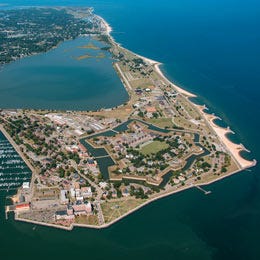The retired Army post Fort Monroe on Point Comfort, Virginia, contains the majestic, moated stone citadel that Civil War self-emancipators called Freedom’s Fortress.
In June, the Self-Emancipator post “Watch out, Fort Monroe: Two threats against national memory at Point Comfort” began this way:
During Trump 2.0, Fort Monroe at Point Comfort, Virginia—the preeminent landscape for public memory of both U.S. slavery’s start in early colonial days and the Civil War’s self-emancipating multitudes—faces two threats: possible closure of Fort Monroe National Monument and the consequent return of Virginia politicians’ parochial zeal for spirit-of-place-hobbling overdevelopment.
What follows below is a version of a short, closely related opinion piece that appeared in the Norfolk Virginian-Pilot and the Newport News Daily Press. Readers of this Substack newsletter are already familiar with much of what it says, but in the present threatening circumstances for decent remembrance of American history, all of it bears repeating.
- - - - - - - - - - - - - - -
World landmark
By Steven T. Corneliussen, who began writing about Fort Monroe in 2005. Email selfemancipator@gmail.com.
Even more than Monticello, Fort Monroe on Point Comfort (look right when nearing Hampton on the bridge tunnel) inherently commemorates the world's first freedom nation's founding. Thankfully, overdevelopment can't threaten Monticello. But it has regularly threatened Fort Monroe since the 2005 announcement of the Army's 2011 departure.
Like Monticello, Point Comfort with Fort Monroe could become a World Heritage Site. It's already becoming a world landmark. But because it's prime waterfront, Virginia officials plan only a “regional landmark.” That means squandering economic potential stemming from world importance within what emancipation historian David Brion Davis meant by calling slavery's eradication “probably the greatest landmark of willed moral progress in human history.”
In The Second Founding, historian Eric Foner proposes that creating the world's first nation founded on freedom—not geography, religion or ethnicity—took from 1776 to the Civil War. Wall Street Journal conservative Jason L. Riley says “What makes America unique is not slavery. It’s emancipation.” Martin Luther King Jr. said “The arc of the moral universe is long, but it bends toward justice.” From 1619 at Point Comfort to the Civil War at Fort Monroe, that arc bent toward emancipation.
In 1619, British North American slavery began when captive Africans arrived at Point Comfort. In a moment weeks after the Civil War began, slavery began to crumble at Fort Monroe, the Union's mighty stronghold in Confederate Virginia. Enterprising slavery escapees sought freedom there. A movement involving a half million self-emancipators resulted. It cascaded across the South, figuring centrally in the war's evolution into a struggle for both Union and freedom.
Former American Historical Association president James M. McPherson, writing in the Virginian-Pilot, once called that Black-initiated Fort Monroe moment “the story of the end of slavery.” Henry Louis Gates Jr. says the same. University of Richmond president emeritus Edward L. Ayers, former president of the Organization of American Historians, calls it “the greatest moment in American history.”
Brent Leggs, African American heritage director at the National Trust for Historic Preservation, cautions that self-emancipation remains an “unknown story.” In 2008, though, McPherson observed that a “self-emancipation thesis” had begun dominating historians' understanding. To help spread that, I publish a nonpaywalled Substack newsletter, The Self-Emancipator.
David W. Blight directs the Gilder Lehrman Center for the Study of Slavery, Resistance, and Abolition. Calling freedom “humanity’s most universal aspiration,” he declares that how “America reimagines its memorial landscape may matter to the whole world.” Yet Virginia's “Reimagine Fort Monroe” web page still proclaims the 2005 vision: “to redevelop this historic property into a vibrant, mixed-use community.” It never even mentions the severely limited, bizarrely split, token Fort Monroe National Monument that politicians contrived on Point Comfort's shoreline in 2011, marginalizing calls for the substantial shoreline national park that's still possible.
McPherson calls Fort Monroe a “world-class destination.” In the New York Times, Adam Goodheart ranked it alongside the Liberty Bell, Plymouth Rock and Gettysburg. Manisha Sinha’s The Slave’s Cause: A History of Abolition says “world historical actions” of the enslaved “forever changed” the dynamics of slavery versus freedom. More than 100 monuments worldwide commemorate Black resistance to slavery. In 2021, UNESCO honored Fort Monroe as a United Nations Site of Memory. As Africa.com, USA Today and the New York Times have reported, Wanda Tucker of Hampton, whose family traces to those Africans of 1619, has inspired transatlantic connections between Point Comfort and Angola, with participation by both countries' presidents. Four Tidewater mayors emphasized Fort Monroe's “special place in world history” when urging national monument expansion. They called for elevating Virginia's Historic Triangle—Jamestown, Williamsburg, Yorktown—to its Historic Diamond by including Fort Monroe.
On a Norfolk State University history panel, former National Park Service chief historian Dwight T. Pitcaithley once asked, “Where’s the national monument to emancipation?” My History News Network essay argues that we already have it: a world landmark, Point Comfort with Fort Monroe.



